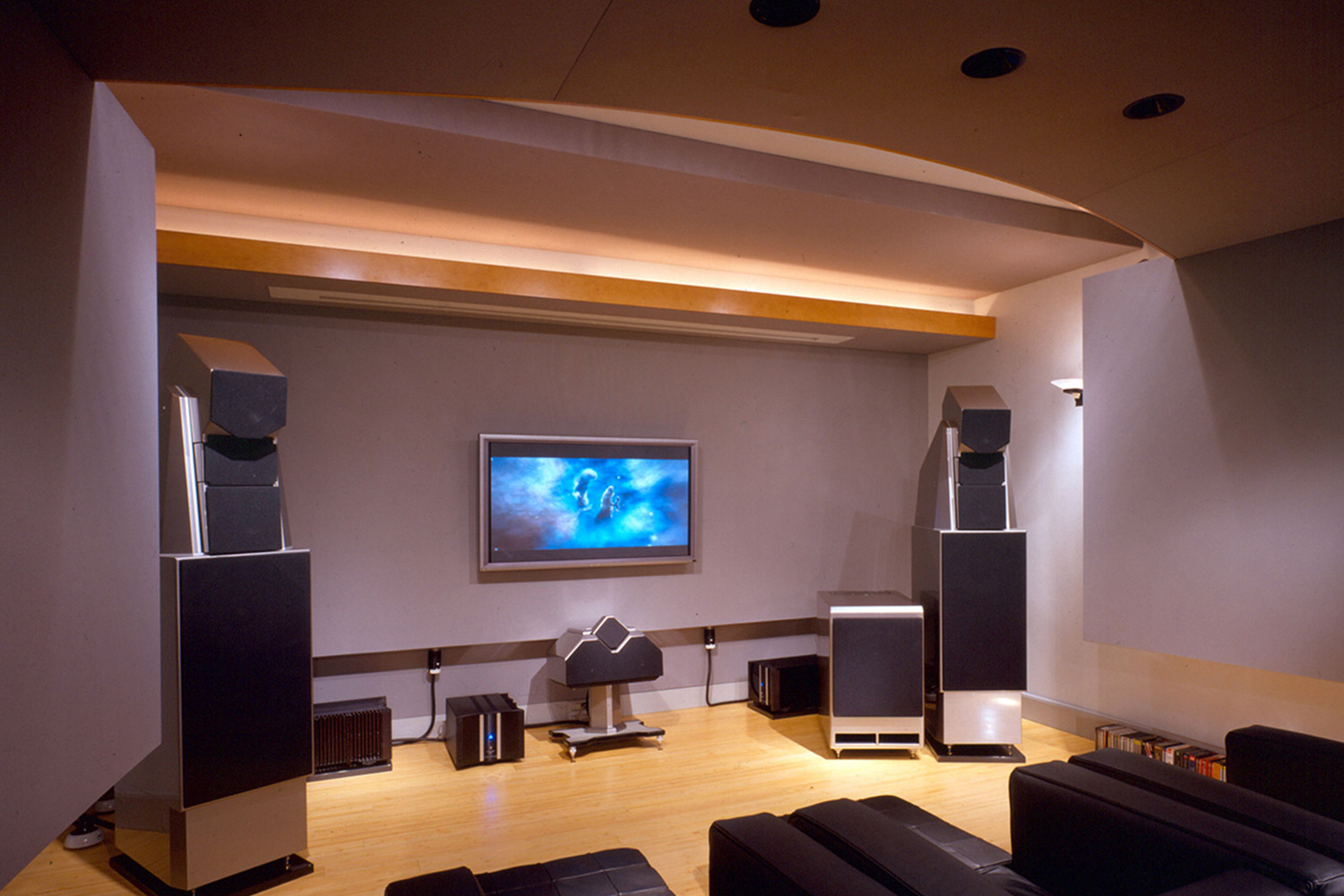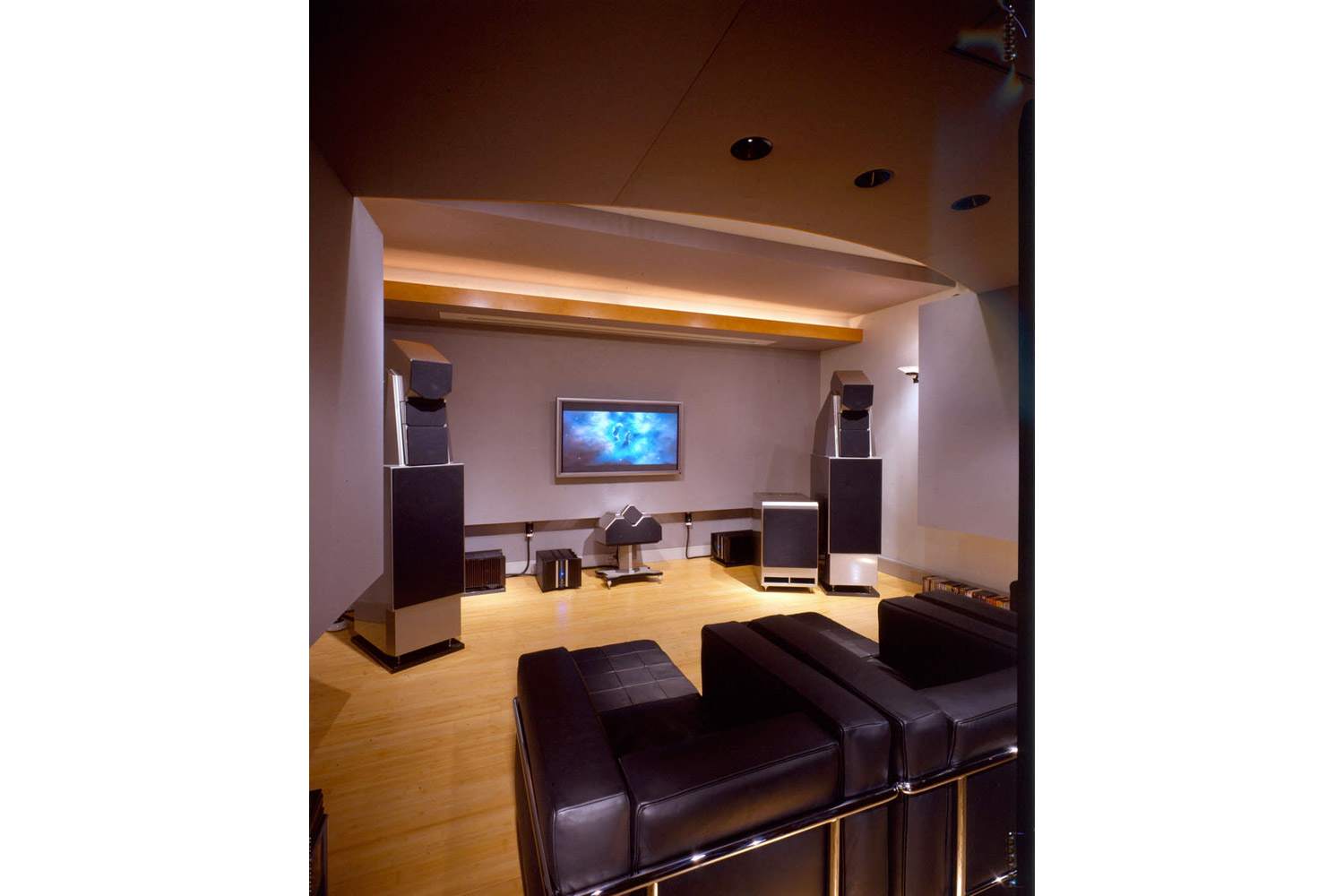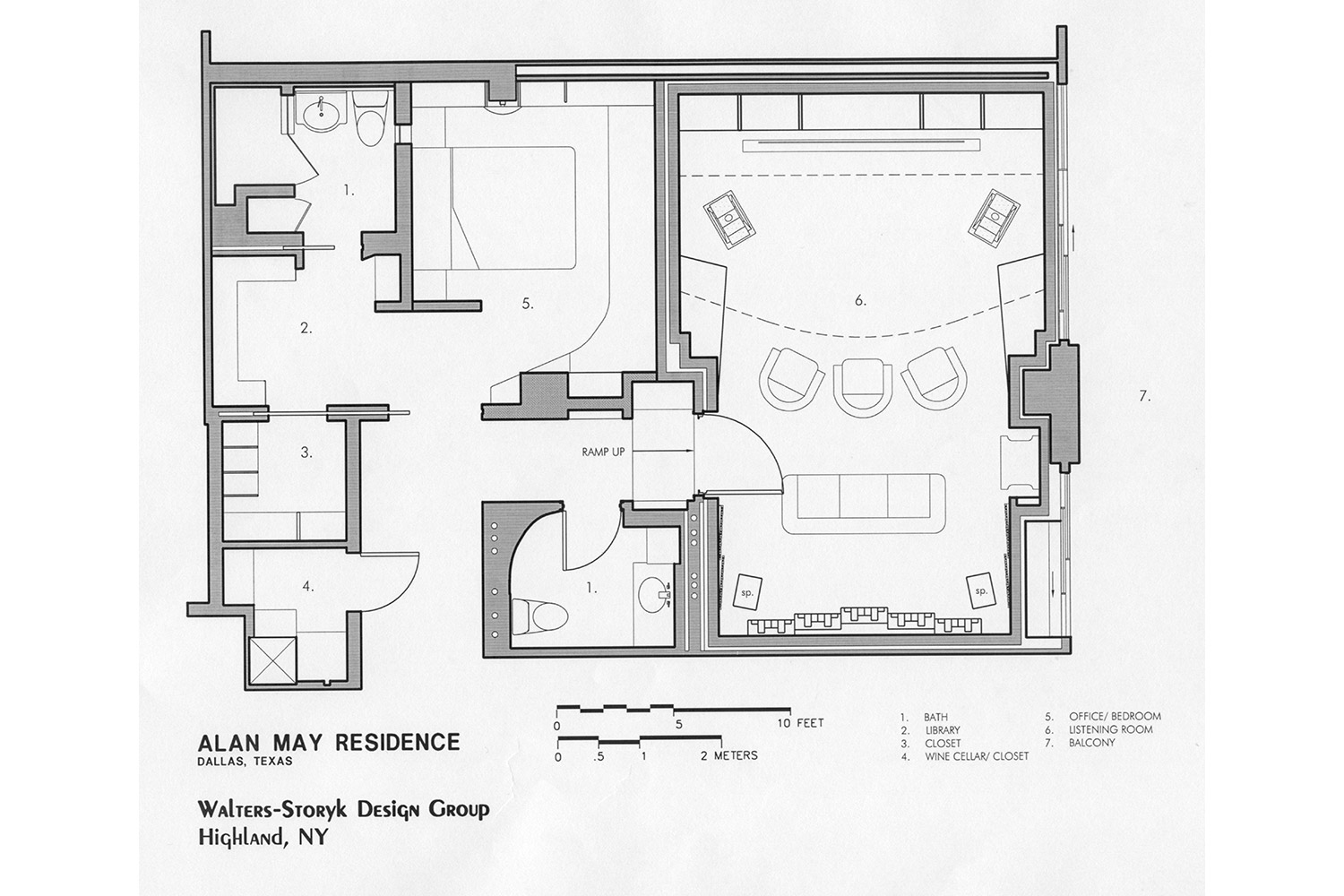Project Description
Overview
After nearly 50 years of enjoying classical music, four years ago I decided to build as close to a world-class Listening Room/Home Theater as I could accommodate in my existing Dallas hi-rise condominium apartment. It took about a year to select the designers, 15 months to design, and another 15 months to build. There was no budget limitation.
Room
Fortunately, there are no load-bearing walls in our building. We could demolish back to the concrete slab. My wife agreed that I could appropriate both our daughter’s former bedroom and the guestroom for the proposed listening room. (This project began when my wife said it was time to change the carpet in the guestroom and I replied that if that was the case I had a few other changes to suggest). I wanted to make the Listening Room as large as possible but was limited by a column protruding from an exterior wall on one side and a bathroom pipe chase on the opposite side. These boundaries held us to an approximate 17′ 8″ by 25′ space with a ceiling height of 9’11”. Space not used for the Listening Room would be used for a small guestroom.
The first challenge was to select the room designer and the basic equipment. A decade earlier, I had installed Krell amps and Mirage M-1 speakers in our New York apartment without making any acoustical modifications to the room. This time I knew that I wanted the best Krell equipment available. I also wanted to audition Wilson and JM Labs speakers.
Finding the right designer was a bit more complicated. I read the literature. I attended hi-end shows in Los Angeles, Chicago, Las Vegas and New York. The problem was that unfortunately nearly everyone I encountered unfortunately had a distinct bias. Not surprisingly, they were selling the equipment lines that they represented. It was odd to learn that many of the top hi-end audio guys seemed less than enthusiastic about home theater and the home theater designers often seemed less sophisticated about outstanding Class A sound.
Finally, I chanced upon Mix magazine and discovered that it had been presenting awards to the top recording studio acoustical designers and acousticians for many years. A careful review of Mix’s award history showed that five firms on the west coast, Dallas and New York were consistent winners and/or nominees for those awards. After considerable research, I pared it down to John Storyk and Sam Berkow of Walters-Storyk Design Group in New York. John visited us three times over the course of the project: once before we got started to take basic measurements, once when the walls of the white box room were up but not yet sealed for an onsite progress inspection, and finally when the project was completed and the equipment installed to measure the results. Everything else was handled by Fed-Ex, e-mail or digital camera. I am thrilled with the results.
We realized early on that the most appropriate construction contractor would be one with previous experience building recording studios. That severely limited our options (and may have added to the cost) but choosing Scott & Reid (Dallas, TX) proved to be the correct decision in the long run. Initially, I was surprised by how long construction actually took. On the other hand, we quickly recognized that a project such as ours is like building an onion, one layer at a time, from the outside in. Case in point, we began by ordering Wilson X-1 Grand Slamm Series I speakers. By the time the project was completed we installed the Series III. Nevertheless, the finished room was well worth it.
Before the room was designed, John Storyk took a guitar amplifier and blasted the loudest sound he possibly could from the area in which the room was to be constructed. He then went to the neighbor’s apartments and measured how much sound was getting through. Using this data, he designed the room so that no matter how much sound was being produced, the neighbors would hear nothing. Since the room was completed there has never been a single complaint from any neighbor. Boundary sound transfer ratings in excess of STC 70 were obtained from the fully isolated room construction.
The Listening Room was built on a floating floor. Actually, six floors. First, a new concrete slab was poured. It was Ardexed, poured both “level” and “flat.” Then, 2″x2″x1″ rectangular rubber “hockey pucks” were placed at 16-inch intervals throughout the room with acoustical batting placed between them. This was accomplished using a “roll-out” integrated flooring system, manufactured by Kinetics Corp. Next, a layer of plywood was laid down; flowed by a layer of sheet rock; then followed by a second layer of plywood. All layers were crossed seamed, screed and glued. Finally, the finished bamboo flooring was installed. Since sound travels in a straight line, the use of six different layers of flooring material each with different densities and other properties has the effect of breaking up any potential sound transmission to the neighbors below. Moreover, the use of the rubber supports enables the floor to move, as necessary, with the sound. Because this six-layer “floating floor” raised the floor level five to six inches above the pre-existing slab, a ramp was constructed leading into the room.
The room’s eight-inch thick walls were built on top of the “floating floor.” First, an 8″ wide layer of rubber insulation was laid down where the walls were to be erected. Next, 1″ by 6″ metal studs were erected on the rubber with acoustical batting placed between the studs. This was followed by three layers of acoustical sheet rock placed on the inside of the walls. For further insurance against sound “leakage,” care was taken so that the sheet rock seams overlapped rather than coincided. Acoustical sealant was used on all seams.
The eight-inch thick ceiling is not suspended. Constructed with 1″ by 6″ by 18′ steel beams, it rests on top of the walls. This creates a fully “lidded” acoustic environment. Acoustical batting was placed between the metal studs. Next, three layers of overlapping acoustical sheet rock were installed. The room is entered through a 2.5″ thick steel acoustic door and frame assembly, manufactured by IAC. Thus, the Listening Room is the equivalent of an isolated freestanding building situated within a conventional high-rise. All four walls and the ceiling are separated from the neighboring rooms and floor above by a “floating” two-inch-wide air pocket. The floor is raised six inches off our neighbor’s ceiling.
The room is served by its own dedicated two-ton HVAC unit located about 30-feet away. All HVAC ducts have been acoustically lined, sound attenuators added, and air circulation has been slowed to approximately 340cf/minute.
Twenty-six RPG custom-designed Modex Modules of different sizes have been installed within the Listening Room behind acoustic stretch fabric in all three dimensions. These 7″ membrane absorbers are tuned to correct low frequency room modes, which were predetermined based on the raw size of the room (width, length, height). Five 2′ maple QRD Diffractals were instellaed in theater of the room as well. The Diffractal is a diffusing fractal. It consists of nested self-similar scaled diffusors, each of which covers a specific frequency range. Smaller diffusing elements (high frequency), “flutter free” (also manufactured by RPG) are mounted on the side walls to create high frequency diffusion and low frequency absorption caused by a Helmhotz resonator mounting system. The finished room is approximately 15′ – 6″ wide at its widest by 22′ 5″ long and 8′ 9″ high at its maximum by 7′ 5″ high at its minimum.
In a room with outstanding acoustics the last thing one wants to do is muffle your ears with a high back chair. We chose six Le Corbusier LC2 chairs plus six ottomans for comfort and the kids. I spend about two hours most nights in the room and try to limit guests to once a week, almost all of whom emerge in a state of amazement as to what true Class A sound can produce.
Equipment
Auditioning very high-end audio equipment is complicated by the fact that no single dealer is likely to carry two competing brands of the finest equipment. Thus the audiophile is reduced to relying on his acoustical memory as he goes from dealer to dealer to compare what he hears. And he can’t be certain that the perceived audio differences are caused solely by the components that he thinks that he is auditioning.
Since only three dealers in the country were authorized for both the Krell Master Reference amplifier and the Wilson speakers, dealer selection was greatly simplified. I used Jim Lee at Nuts About Hi-Fi in Seattle. A nicer guy you couldn’t hope to find. When we realized that the Master Reference amps would take up too much of our limited real estate, we switched to the Krell Full Power Balanced 650Mcs amps. I had run dedicated 50-amp circuits on 8-gage wire to the wall outlets serving each of the Krell 650Mcs and wanted to use 50-amp Hubbell plugs and receptacles. Lee arranged for Krell to build a custom 8-gage power cord on the 650s using the 50-amp Hubbell plugs that I supplied. You could weld with these babies. They sound great and run cool. Mike Fredericksen from Wichita built a custom equipment stand with adjustable MDF shelves. The stand is made from 3/16″ steel, powder coated and filled with sand. A Krell KPS 25sc CD player, an active Vibraplane (the compressor is in a nearby closet together with all the Lutron gear and associated lighting transformers) and a PS Audio P600 Power Plant round out the balance of the major audio equipment.
We originally planned a dedicated music Listening Room with the option of adding a full-blown home theater. I naively thought that three years of “just music” before going on to movies would be quite nice. But no sooner did visitors hear the room than they all asked for movies – and, once my wife saw the possibility, it became inevitable. Recognizing the advantages of 5.1 surround sound, we added a pair of Wilson Watt Puppy 6.0s in the rear corners, a Wilson WATCH-Center speaker and a Wilson WATCH Dog powered subwoofer. All our speakers are finished in light titanium. Three Krell FPB 350Mc amps power the Watt Puppys and the WATCH-Center while a Krell Home Theater Standard audio video preamp controls operations. When showing movies in this room the sound sounds as though it is on steroids. There is a sense of a great soundstage in all directions. The room is so quiet that you can hear the silence in your own head between the notes of a fine performance.
When it came to selecting a projector, we ruled out nearly every product presently on the market. Most of them were originally designed for commercial use and are just too noisy for our small room. Perhaps, if our ceiling were higher, we wouldn’t be able to hear a projector’s fan. At the 2001 CES in Las Vegas last January I finally heard one projector (newly designed specifically for home theaters) that is truly quiet. Alas, its picture isn’t really quite there. Nevertheless, given the progress that the industry is constantly making, we are optimistic that a truly quiet projector with a great picture will become available within the next 24 months. In the interim we are showing our DVDs on a 50″ Pioneer plasma screen supported by a Faroudja Native Rate Series Digital Video Processor. A Hughes Platinum High Definition Digital Video Processor and a Denon DVD player round out the video equipment roster. Krell CAST, Cardas and Audioquest audio and video cables are used throughout.
We haven’t yet opted for a Crestron or equivalent control system. After all this is only a single room installation. However, I am sure a touch-screen control is somewhere in our future. I am currently in the process of adding a VCR and a European PAL laserdisc player (for those Berlin, Bayreuth, Munich, Vienna and Salzburg opera productions which aren’t likely to be released over here anytime soon). For the future, we will add that ideal projector with a line enhancer and also audition some of the more exotic cable products, spikes and other promising tweaks.
We have about 100 DVDs, 600 CDs and are constantly adding. My favorite DVD for showcasing the room is Contact. My favorite CDs for showcasing are Fred Astaire’s monaural “Steppin’ Out”, Ella Fitzgerald singing “Night in Tunisia” on Clap Hands, Here Comes Charlie!, Arthur Rubinstein performing Chopin’s Nocturne Op. 9, no. 2 in E-flat, and Heifetz performing the second movement of the Mendelssohn Violin Concerto.
Equipment List
Speakers
- Left & Right front mains Wilson X-1 Grand Slamm Series III
- Left & Right rear surrounds Wilson WATT Puppys Series 6.0
- Front Center Wilson WATCH-Center Subwoofer Wilson WATCH Dog powered subwoofer
- *All speakers finished in light titanium
Amps
- A pair of Krell Full Power Balanced 650Mc amplifiers w/custom 50-amp plugs
- Three Krell Full Power Balanced 350Mc amplifiers
- The subwoofer has its own built-in amplifier
Other
- One Krell KPS 25sc Krell Playback System (CD player with pre-amp)
- One Sounds of Silence Kinetic Systems Model 2212 Active Air Vibraplane (vibration de-coupler)
- One PS Audio P600 Power Plant (AC regenerator) from AudioNut
- One Krell Home Theater Standard (audio-video pre-amp)
- One Pioneer PDP-505 HD 50″ Plasma Display
- One Faroudja Native Rate Series Digital Video Processor (line-doubler)
- One Hughes Platinum HD Digital Satellite Receiver
- One Denon DVD-2800 DVD player One custom built equipment stand by Mike Fredericksen
- One Stewart Studiotek 130 flexible projection screen with ElectriMask
- Three Electro-Kinetics custom designed ceiling projector lifts
Cables
- Audioquest Everest speaker cables
- Cardas Neutral Reference speaker cables
- Krell CAST cables with Krell current mode technology
- Wilson Puppytails
- Audioquest: various audio and video cables
- Cardas: various audio cables Misc. Elevators
Acoustics
- RPG Modex panels (26)
- RPG 4″ wide wood flutterfree with Helmhotz resonator mounting
- RPG 24″ wide wood diffractal (maple)
- Kinetics – roll out flooring – 2″ isolators
Furniture
- Six Cassina Le Corbusier LC2 black leather chairs
- Six DeSede black leather ottomans





